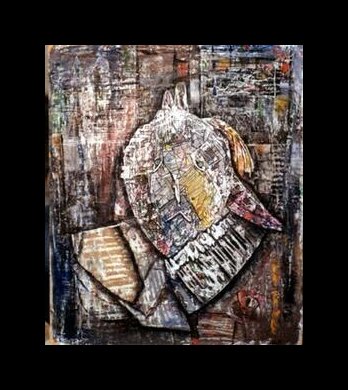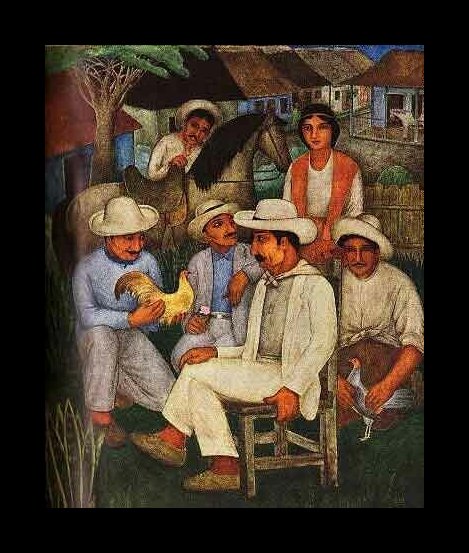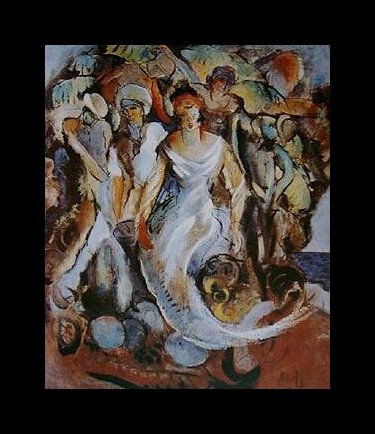Eduardo Abela (1902-1982)
Get a Eduardo Abela (1902-1982) Certificate of Authenticity for your painting (COA) for your Eduardo Abela (1902-1982) drawing.
For all your Eduardo Abela (1902-1982) artworks you need a Certificate of Authenticity (COA) in order to sell, to insure or to donate for a tax deduction.
Getting a Eduardo Abela (1902-1982) Certificate of Authenticity (COA) is easy. Just send us photos and dimensions and tell us what you know about the origin or history of your Eduardo Abela (1902-1982) painting or drawing.
If you want to sell your Eduardo Abela (1902-1982) painting or drawing use our selling services. We offer Eduardo Abela (1902-1982) selling help, selling advice, private treaty sales and full brokerage.
We have been authenticating Eduardo Abela (1902-1982) and issuing certificates of authenticity since 2002. We are recognized Eduardo Abela (1902-1982) experts and Eduardo Abela (1902-1982) certified appraisers. We issue COAs and appraisals for all Eduardo Abela (1902-1982) artworks.
Our Eduardo Abela (1902-1982) paintings and drawings authentications are accepted and respected worldwide.
Each COA is backed by in-depth research and analysis authentication reports.
The Eduardo Abela (1902-1982) certificates of authenticity we issue are based on solid, reliable and fully referenced art investigations, authentication research, analytical work and forensic studies.
We are available to examine your Eduardo Abela (1902-1982) painting or drawing anywhere in the world.
You will generally receive your certificates of authenticity and authentication report within two weeks. Some complicated cases with difficult to research Eduardo Abela (1902-1982) paintings or drawings take longer.
Our clients include Eduardo Abela (1902-1982) collectors, investors, tax authorities, insurance adjusters, appraisers, valuers, auctioneers, Federal agencies and many law firms.
We perform Eduardo Abela art authentication, appraisal, certificates of authenticity (COA), analysis, research, scientific tests, full art authentications. We will help you sell your Eduardo Abela or we will sell it for you.
Though he was born in Cuba, it was not until he traveled and studied abroad that Eduardo Abela discovered his passion for painting themes of his home country. He graduated from the San Alejandro Academy of Fine Arts in 1921. While studying in Paris and Spain in the 1920s, Abela developed his own style of painting, which was a mixture of expressionism and African and Creole styling. He would later study the old masters as well as contemporary painters to create an ever changing style. No matter his style, Abela was always true to the theme of Cuban history and culture.
During his lifetime, Abela was an artist, a teacher and a political activist. He founded a school of art for the San Alejandro Academy in 1937 called “The Free Studio of Painting and Sculpture.” This was a short-lived school, but it gave an alternative to the upper class teachings of the San Alejandro Academy.
Abela’s color palette was warm and bright, and he often used hues relative to Cuban heritage, like yellows, reds and other earthy tones. He painted in oil, composed many drawings and often used real earth elements, such as masonite as his canvas. The particular painting, “Rostro” (1952), is a great example of some of Abela’s later work. It was highly textured and the themes of his work echoed some of the political and social movements of the time in Cuba. “Rostro” translates into “Face” in English. At this time, he was studying the work of Picasso and Klee, and it is reflected in his work. His later paintings were very different from his earlier style, as is common with most artists.

Although his work is dominated by scenes with figures, Abela also painted cityscapes, portraits and cartoons. His cityscapes were dreamlike, his portraits soft and his cartoons had a social message. One particular cartoon character, Bobo (the fool/clown), became very popular in Cuba and was meant to be satirical and represented his personal fight against the Machado dictatorship. Bobo had a very popular following and quilts, t-shirts and more were made donning his visage.

One will notice the everpresence of figures in Abela’s painting, be it a distorted face or a group of dancing women. He would paint the rural citizens of Cuba, traditional and contemporary, with a very personal touch. His soft lines and colors gave peasant women and a group of rural men and their livestock a soft glow and a positive ambiance that few other artists of the time cared to. His village scene “Guajiros” (1937) is one of his most famous and truly embodies the way in which he portrayed his subjects. Abela was also noted as being one of the first to introduce black or “negro” subjects into his paintings, something that had been formerly left out of Cuban art.

It may be hard to decipher whether you have an original Abela because his range in style from painting to painting differs. Abela absorbed new ideas in art and through his studies and introductions to new art styles, he adapted his own manner. Another of his more popular paintings, “El Triunfo de la Rumba” (1928), is clearly full of expressionist and impressionist influences. However, he also painted beautiful naturalistic portraits, such as “Santa Fe” (1936).


Abela did quite a bit of traveling in his lifetime; Spain, France, Guatemala and Mexico to name a few. He held diplomatic positions in Guatemala and Mexico from 1942 to 1952, and was said to have produced little artwork during this decade. However, he may have produced work there during his diplomacy or while studying abroad in Europe that is yet to be discovered and authenticated.
Eduardo Abela is a prominent name in Cuban art, not only because of his popularity, but also because of his lineage. His son and grandson bear his name and are also artists. This may cause confusion in authenticating a work from the senior Abela for obvious reasons. Fortunately, each generation of Eduardo Abelas has their own style, so an expert authenticator will know the difference between each artists’ hand. Eduardo Miguel Abela Torras, has a penchant for painting surreal abstract scenes of Cuban history, and his work could never be confused with that of the senior Abela. He sometimes borrows ideas from Andy Warhol, such as using the Campbell’s soup can and replacing the Mona Lisa’s head with that of Marilyn Monroe.
The work of Eduardo Abela is housed in private collections, as well as in the National Museum in Havana. Much of his work is privately owned in the Caribbean, as well as the United States, leaving a great deal of possibility for new discoveries.
Reviews
1,217 global ratings
5 Star
4 Star
3 Star
2 Star
1 Star
Your evaluation is very important to us. Thank you.
